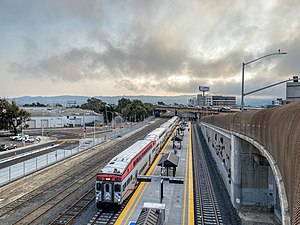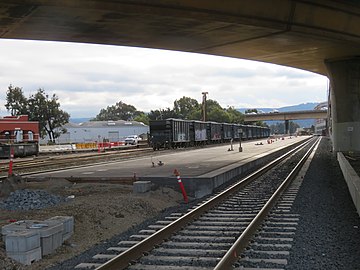
Caltrain is a commuter rail line in California, serving the San Francisco Peninsula and Santa Clara Valley. The southern terminus is in San Jose at the Tamien station with weekday rush hour service running as far as Gilroy. The northern terminus of the line is in San Francisco at 4th and King Street. Caltrain has express, limited, and local services. There are 28 regular stops, one limited-service weekday-only stop, one weekend and holiday-only stop (Broadway), and one stop that is only served on football game days (Stanford). While average weekday ridership in 2019 exceeded 63,000, impacts of the COVID-19 pandemic have been significant: in June 2024, Caltrain had an average weekday ridership of 24,580 passengers.

The Third Street Light Rail Project was the construction project that expanded the Muni Metro system in San Francisco, California, linking downtown San Francisco to the historically underserved southeastern neighborhoods of Bayview-Hunters Point and Visitacion Valley along the eastern side of the city. Construction was finished in late 2006, non-revenue weekend service began on January 13, 2007, and full service began on April 7, 2007. The new service, as the T Third Street Metro line, replaced the 15 Third bus line, which ran south from the Caltrain Depot at 4th and King streets, along Third Street and Bayshore Boulevard to the southeastern neighborhoods.

Balboa Park station is a Bay Area Rapid Transit (BART) station and Muni Metro complex in the Mission Terrace neighborhood of San Francisco, California, located near the eponymous Balboa Park. It is an intermodal hub served by four BART routes, three Muni Metro lines, and a number of Muni bus routes. The station complex also includes two rail yards, Cameron Beach Yard and Green Light Rail Center, where Muni maintains Muni Metro trains and heritage streetcars. BART uses a below-grade island platform on the west side of the complex; Muni Metro routes use several smaller side platforms located on surface-level rail loops around the yards.

Millbrae station is an intermodal transit station serving Bay Area Rapid Transit (BART) and Caltrain, located in Millbrae, California. The station is the terminal station for BART on the San Francisco Peninsula, served by two lines: The Red Line before 9 pm and the Yellow Line during the early morning and evening. It is served by all Caltrain services. The station is also served by SamTrans bus service, Commute.org and Caltrain shuttle buses, and other shuttles.
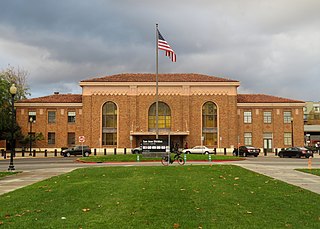
San Jose Diridon station is the central passenger rail depot for San Jose, California. It also serves as a major intermodal transit center for Santa Clara County and Silicon Valley. The station is named after former Santa Clara County Supervisor Rod Diridon Sr.

Downtown Mountain View station is an intermodal transit station providing public bus and rail service, located in Mountain View, California. The station is served by the Caltrain commuter rail service, for which it is simply called Mountain View station. Santa Clara VTA Orange Line light rail service is provided to an adjacent, dedicated light rail facility, known as Downtown Mountain View station. VTA local transit bus and employer-operated shuttle services are accommodated from the Mountain View Transit Center on the Evelyn Avenue side of the station.

Santa Clara Transit Center is a railway station in downtown Santa Clara, California. It is served by Caltrain, Amtrak Capitol Corridor, and Altamont Corridor Express (ACE) trains. It is the planned terminus for the Silicon Valley BART extension into Santa Clara County on the future Green and Orange Lines. The former station building, constructed in 1863 by the San Francisco and San Jose Railroad, is used by the Edward Peterman Museum of Railroad History.

Palo Alto station is an intermodal transit center in Palo Alto, California. It is served by Caltrain regional rail service, SamTrans and Santa Clara VTA local bus service, Dumbarton Express regional bus service, the Stanford University Marguerite Shuttle, and several local shuttle services. Palo Alto is the second-busiest Caltrain station after San Francisco, averaging 7,764 weekday boardings by a 2018 count. The Caltrain station has two side platforms serving the two tracks of the Peninsula Subdivision and a nearby bus transfer plaza.

22nd Street station is a Caltrain commuter rail station located south of 22nd Street between the Dogpatch and Potrero Hill neighborhoods of San Francisco, California beneath the Interstate 280 freeway viaduct. The only below-grade Caltrain station, it is bracketed on the north and south by two tunnels which take the line under the eastern slope of Potrero Hill. The station is also served by Muni routes 48 and 55.

Bayshore station is a Caltrain commuter rail station in the Visitacion Valley neighborhood of San Francisco, California. The station is on the border of San Francisco and the neighboring city of Brisbane. The parking lot and the northern section of the station are in San Francisco, while the remainder is in Brisbane. The station address is in San Francisco proper.

San Bruno station is a Caltrain station located in San Bruno, California. The station is located just northeast of downtown San Bruno, above the intersection of San Mateo and San Bruno Avenues, adjacent to Artichoke Joe's Casino.
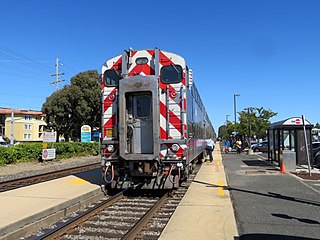
Broadway station is a Caltrain station in Burlingame, California, originally built for the Southern Pacific Railroad in 1911. Since 2005, Caltrain only serves the stop on weekends and holidays; weekday service is provided by a bus shuttle to nearby Millbrae station. A planned grade separation project for the nearby level crossing at Broadway is scheduled to open by 2027, alleviating street congestion and restoring weekday service.
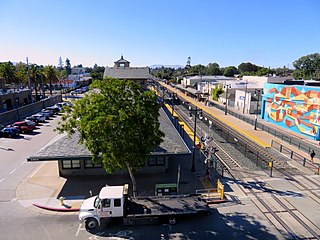
San Mateo station is the northernmost of the three Caltrain stations in San Mateo, California. It is in downtown San Mateo.

Hillsdale station is one of three Caltrain stations in San Mateo, California. The station is next to the Bay Meadows neighborhood and close to the Hillsdale Shopping Center.
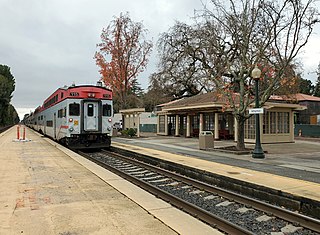
Atherton station was a Caltrain station in Atherton, California. The station had one side platform and one island platform serving the two tracks of the Peninsula Subdivision, with a concrete and wooden shelter on the west side of the tracks. The station opened by the Southern Pacific Railroad in 1866 as Fair Oaks and was renamed Atherton in 1912. Caltrain cut weekday service to the station in 2005 due to low ridership and a hold-out rule that prohibited two trains from being at the station simultaneously. Weekend and holiday service continued until December 19, 2020.

Paul Avenue station was a Caltrain station located in the Bayview neighborhood of San Francisco, California. The lightly used station was closed on August 1, 2005, and the platform and shelter were removed in 2009. A replacement station to the north has been proposed.
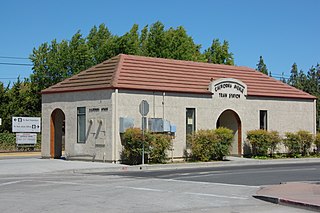
California Avenue station is a Caltrain station located in Palo Alto, California. It stops at the historical town center of Mayfield, which was annexed by the town of Palo Alto in 1925. The current station structure was built in 1983 and the station was expanded from one platform to two in 2008.
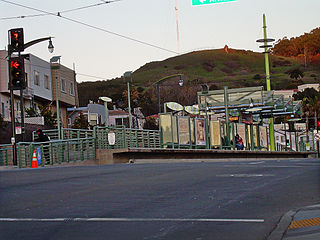
Arleta station is a light rail station on the Muni Metro T Third Street line in the Visitacion Valley neighborhood of San Francisco, California on the south slope of Candlestick Hill. The station opened with the T Third Street line on January 13, 2007. It has a single island platform located in the median of Bayshore Boulevard between Arleta Avenue and Blanken Avenue, with access from crosswalks at both streets.

The Caltrain Express Program (CTX) was implemented from 2002 to 2004 to establish the Baby Bullet express service, which shortened the transit time on the Caltrain commuter rail line between San Francisco and San Jose, and certain stations in between. New locomotives and rolling stock were purchased for dedicated express service, bypassing most stations; quad-track overtake sections were added in two locations along the Peninsula Corridor right-of-way to allow express trains to pass slower local trains that were making all stops; tracks were also upgraded with continuous-welded rail; a centralized traffic control system was added; and crossovers were added every few miles to allow single-tracking trains around disabled trains. Congresswoman Jackie Speier, then serving as a California State Senator, is credited with securing the funding for CTX and one of the new locomotives acquired for the project is named for her as a result. During commute hours, the Baby Bullet went up to 20 percent faster than driving south from San Francisco to San Jose. On September 21, 2024, with the completion of the Caltrain modernization project and the transition to electrified trains, the Baby Bullet was renamed as simply the Express service.

The Portal, also known as the Downtown Rail Extension (DTX), is a planned second phase of the Salesforce Transit Center. When complete, it will extend the Caltrain Peninsula Corridor commuter rail line from its current northern terminus at 4th and King via a 1.3-mile (2.1 km) tunnel. The new terminus will be near the Financial District and will provide intermodal connections to BART, Muni, Transbay AC Transit buses, and long-distance buses. In addition, the California High Speed Rail Authority (CHSRA) plans to use DTX and the Caltrain-owned Peninsula Corridor for service on the CHSRA San Francisco–San Jose segment. The Caltrain Modernization Program (CalMod), which included electrification of the line and acquisition of electrified rolling stock, was a prerequisite, since the former diesel locomotives were not suitable for use in a tunnel.
